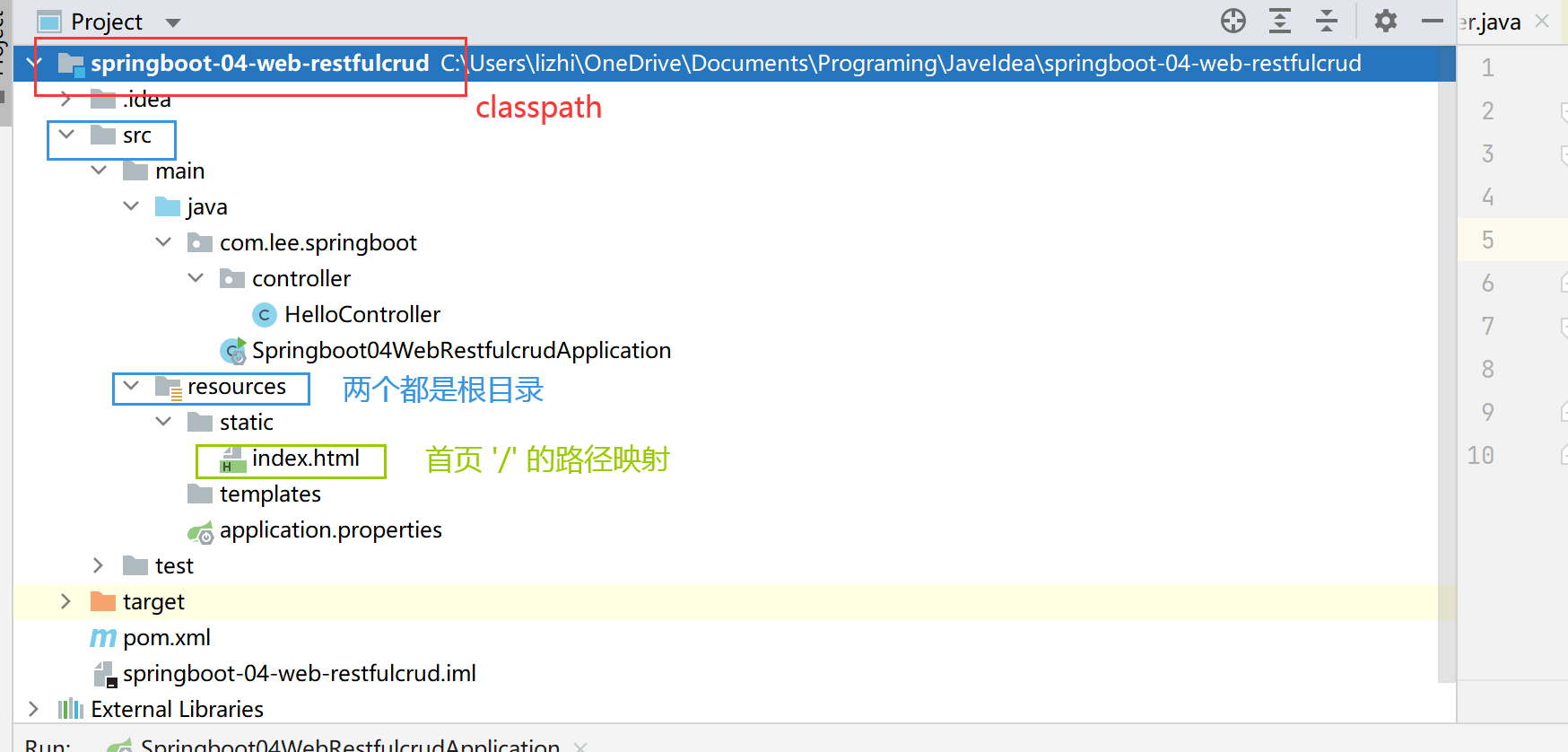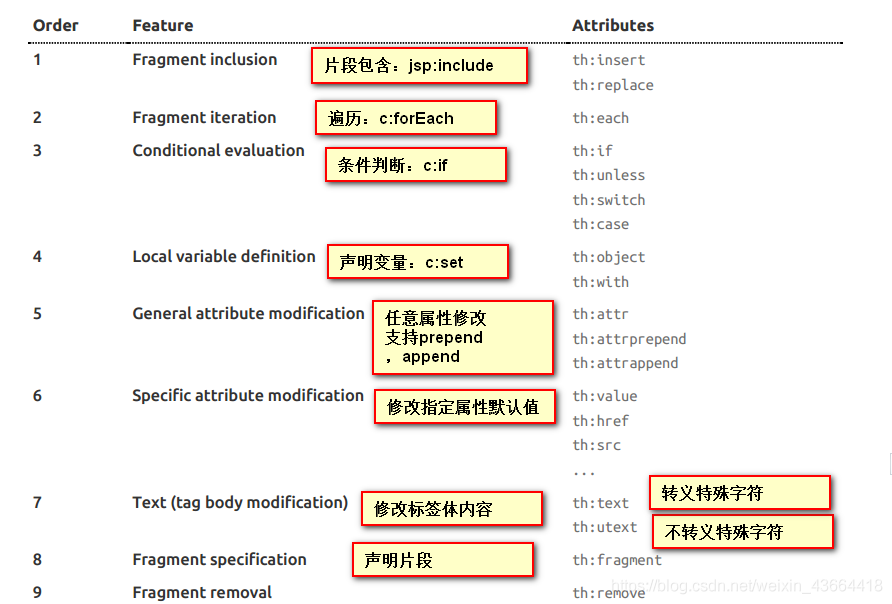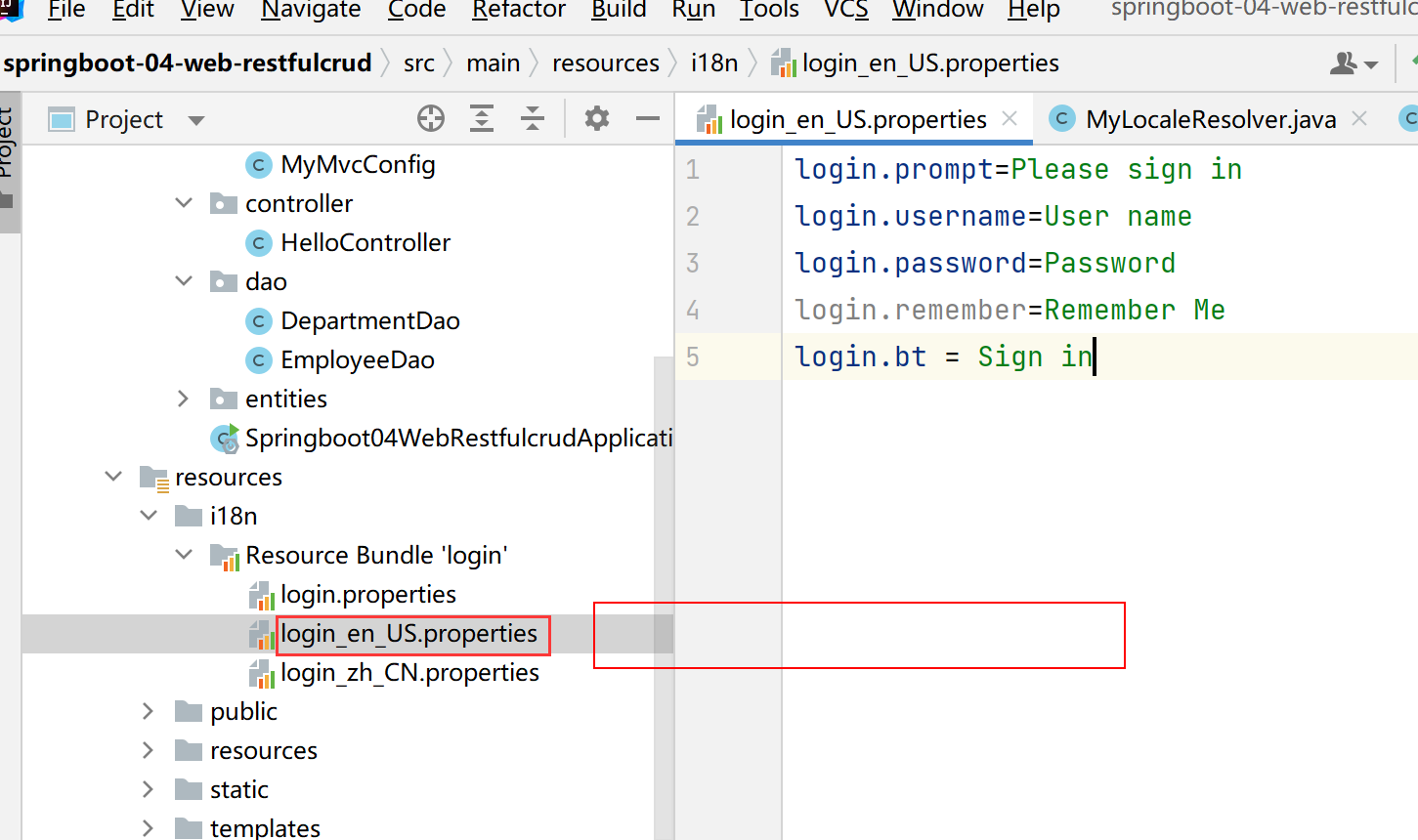springboot-尚硅谷
本文最后更新于:2021年12月22日 中午
一、SpringBoot入门
1.spring boot简介
spring boot的特点
- boot整合了spring的各种技术栈,比如security、cloud等
- boot简化spring的配置文件
- 项目可以以jar包的形式运行,而不是war
- boot是spring框架的框架
2.微服务
由martin fowler的一篇文章而来。微服务是一种应用架构风格。传统的单体应用,应用的所有功能都装在一个应用里,当整个项目十分庞大以后,不利于应用的扩展。所以将整个应用按照功能进行拆分,这就是微服务。 拆分后,就可以对应用的功能进行单独升级和替换。
总之,这些调整的一切目的几乎都是为了减少大型项目的复杂度,通过分工合作的方式提高效率。
3.环境配置
初始环境
- jdk1.8+
- maven3.3+
- idea2017+
- spring-boot1.5.9Release
maven配置
在maven的config文件中加上这段
1 | |
idea配置
把idea自带的maven替换为我们自己安装的maven,路径为:settings/buildtools/maven
4. spring-boot hello world
spring boot的hello world步骤:
4.1创建maven项目,不使用模板
4.2添加spring boot依赖
1 | |
这里出现了一个问题,一开始给maven配置编译的jkd时一个标签的结束符号忘记打了,所以就导致pom一直爆红。后面查看具体错误报告时才发现问题所在,所以以后要仔细检查错误报告。
4.3编写代码
4.3.1创建spring boot 主类
1 | |
4.3.2创建controller类
1 | |
4.4 运行spring boot主类,就是HelloWorldMainApplication类
4.5 简化部署
通过把项目打成jar包的形式简化部署的流程,jar包内置tomcat,意味着即使服务器没有tomcat也可以运行项目。
添加插件的依赖后即可打jar包。
1 | |
- 使用
maven package命令进行打包 - 打好的包在target中
- 使用
java -jar运行jar包
5.Hello world的细节
spring boot为我们简化了很多操作,这正是通过我们一开始导入的两个依赖完成的。
5.1 boot-starter依赖
1 | |
spring boot 的版本中心,里面有常用依赖的版本号。有了它可以少些一部分的版本号。
5.2 boot-starter-xxx依赖
1 | |
springboot 把一个个功能场景拆开,分成starter的形式。我们需要用什么功能就写相应的依赖,一切都会自动进行。除了boot-starter-web,还有比如boot-starter-security
5.3 @SpringBootApplication
这个注解里面也是一些额外注解(组合注解),算是为了简化注解的标注,把里面的注解都整合成一个@SpringBootApplication注解。
它就代表一个springboot应用。
@EnableAutoConfiguration/@AutoConfigurationPackage用来自动开启包扫描,它会自动扫面启动类下面的包(controller)。
自动配置注解的@EnableAutoConfiguration目的就是为了给我们的springboot程序导配置文件,导包,开包扫描,它内置了各种组件的注解,都是为了减少我们的操作步骤。
@SpringBootConfiguration,标识这是一个springboot的配置类,里面则是一个@Configuration注解,表示一个spring的注解。
6 springboot-initializer
idea中继承了一个initializer可以帮助我们快速构建一个springboot项目。
构建完成后的项目包括
- 启动类
- resource文件夹
- template静态网页模板(由于内置tomcat,springboot不支持jsp)
- static静态资源文件夹
- application.properties:spring的配置文件
二、yaml语法与配置文件
1.yaml是什么
yaml是一种比xml更优秀的用来表示数据的文件类型。对比:
1 | |
1 | |
相比之下,xml将大部分字符放在了开始和结束标签上,浪费了相当多的存储空间。yaml不仅更简洁,结构也更清晰。
2.yaml怎么写
- yaml的语法规则区分大小写
- yaml数据的层级关系通过缩进来区分
1
2
3
4
5
6
7# k: v 对前需要加空格,否则无法识别
server:
port: 8080
name: YiAn
# yaml中,字符串不需要被单双引号引上,单双引号的使用具有其他意义
# 单引号表示忽略特殊字符,原样输出。比如:hello \n world 会被原样输出为:hello \n world
# 双引号会转义特殊字符,比如:hello \n world 输出为: hello 换行符 world - yaml中特殊数据语法基本不变,通过层级体现
1
2
3
4
5
6
7
8
9
10
11
12
13# 对象语法
person:
name:zhangsan
gender:man
#或者
{name:zhangsan,gender:man}
# 集合语法
fruits:
- apple
- pear
- buleberry
#或者
[apple,pear,buleberry]
3.获取配置文件的值
- 使用bean来获取yaml的值,先写一个实体类
1
2
3
4
5
6
7
8
9
10
11
12// 标识类为组件,只有组件才能使用容器中的功能,比如下面的注解生效
@Component
// 表示类为属性配置类,prefix 表示要读取的前缀。
@ConfigurationProperties(prefix = "person")
public class Person {
String name;
Integer age;
Map<String,Object> map;
String[] array;
Dog dog;
// getters and setters...
} - 添加配置文件处理器的依赖
1
2
3
4
5
6<!--导入配置文件处理器,配置文件进行绑定就会有提示-->
<dependency>
<groupId>org.springframework.boot</groupId>
<artifactId>spring-boot-configuration-processor</artifactId>
<optional>true</optional>
</dependency> - 编写测试类 这种方式也可以直接适用于读取properties文件
1
2
3
4
5
6
7
8
9
10
11
12//导包的时候一定要到junit.test的包;而不是jupiter
import org.junit.Test;
@RunWith(SpringRunner.class)
@SpringBootTest
public class HelloWorldMainApplicationTests {
@Autowired
private Server person;
@Test
public void contextLoads() {
System.out.println(person);
}
}
4.@Value注解和@ConfigurationProperties注解
@Value注解用于给单个属性注入值,而@ConfigurationProperties用来给整个类的属性注入。
@Value特性:
- 单个注入属性
- 语法严格
- 支持spring表达式
- 不支持jsr303数据校验
- 不支持复杂数据(对象类型)封装
@ConfigurationProperties特性
- 给整个bean批量注入属性
- 语法松散,比如支持
person.lastName == person.last-name - 不支持spring表达式
- 支持303数据校验
- 支持对象封装
4.1@Value的补充知识
1 | |
5.@PropertySource&@ImportResource&@Bean三个注解
5.1@PropertySource注解
因为一个项目一般需要多个配置文件,所以可以在类上再加上一个@PropertySource注解来指定导入某个配置文件。它只支持properties文件,不支持yaml文件。
5.2@Bean注解(Recommand)
springboot推荐使用@Bean注解进行组件注入
1 | |
5.3@ImportResource注解(Deprecated)
1 | |
6.配置文件的占位符
无论是yaml还是Properties都可以使用占位符。
1 | |
7. 多配置文件的使用
一个项目不止一个配置文件,开发环境一种配置,生产环境一种配置。所以需要学习多配置文件的使用。
7.1properties多配置文件
程序主配置文件是application.properties,其它环境的配置文件可以是application-dev.properties,通过短横杠区分不同的配置环境。最后通过spring.profiles.active=dev激活具体的配置文件
72.yaml多配置文件
yaml在一个配置文件内就可以区别多种环境
1 | |
除了在yaml中的标识激活哪个配置,还可以通过传入启动参数的方选择激活。在idea中配置parameterspring.profiles.active,或者命令行传入spring.profiles.active=dev
8.配置文件优先级
springboot 启动会扫描以下位置的application.properties或者application.yml文件作为Spring boot的默认配置文件
1 | |
高优先级会覆盖低优先级的文件。如果合理使用,高低优先级配置文件还可以实现互补配置的效果,即低优先级补充配置高优先级中没有配置的文件。
此外,也可以强制指定外部路径为配置文件,还是通过在启动时添加参数的方式。
1 | |
不过,即使是在低优先级的yaml文件中指定参数spring.profiles.active=dev或者命令行传入参数spring.profiles.active=dev,都能覆盖掉高优先级文件的配置。
9.加载外部的配置文件
项目打好包之后如果想临时更改某些配置参数,可以直接在命令号中传入具体参数名。比如临时修改端口号 java -jar springboot-helloworld.jar --server.port=8290,这种优先级最高。类似!impotant。
对于打好包的项目,如果参数有很多的话,也可以直接在jar包的同级目录放一个application配置文件。
btw,.properties文件总是比.yml文件拥有更高的优先级,如果同级目录下既有一个properties又有yml,那么前者生效。
10.自动配置的原理
springboot帮我们完成了大量的配置工作,我们也可以按照需要手动配置某些值
引用笔记
1 | |
10.1 @Conditional注解
springboot有许多@conditionalOnxxx注解,用于条件成立的情况,使配置内容生效。
虽然springboot内置了大量的自动配置类,但并不是全都会生效。我们可以通过在配置文件中添加 debug=on 属性,开启springboot的debug模式,从而查看当前项目有哪些自动配置类生效了。
三、日志系统
目前的日志系统类似于JDBC和数据库驱动一样。现有一个日志接口层,然后再有不同的日志接口实现类。SpringBoot使用的日志接口是SLF4J,接口实现是Logback。
1 日志的使用
和JDBC类似,使用日志使掉的是接口层的方法,不需要去关心实现层是什么样的方法。实际使用时,调用SEL4J的方法就行,尽管它有多种的实现层。
2. 日志配置文件
日志的配置文件还是依据实现类的不同来完成。毕竟sel4j只是提供一个抽象方法给我们调用。
3. 统一日志系统
一个项目中可能涉及多个框架,而不同的框架使用的是不同的日志接口。我们需要统一日志接口。
以slf4j为例:
- 系统框架中的其它日志系统排除
- 用中间包替换原有的日志框架,中间包是一个类似于原有框架,但实际上是转向slf4j的一个包
- 导入slf4j的实现类
4. SpringBoot的日志关系
通过查看springboot项目的依赖关系图,我们确认了springboot使用的是slf4j作用日志接口,logback作为日志实现;同时,springboot还通过日志转换包,把其它日志系统转为slf4j,然后用logback实现。
SpringBoot能自动适配所有的日志,而且底层使用slf4j+logback的方式记录日志,引入其他框架的时候,只需要把这个框架依赖的日志框架排除掉即可。
1 | |
5. springboot日志的使用和基本配置
1 | |
1 | |
除了配置日志的级别还可以调整日志的输出格式,输入到本地硬盘的某个位置。
1 | |
6. 配置日志By文件
日志系统会读取org.springframework.boot.logging包里的配置文件,我们也可以自己写一个类似的配置文件来进行覆盖。
有两种方式:
- logback.xml:这种方式会直接被日志系统识别并加载
- logback-spring.xml:日志系统无法识别这种文件,是由springboot解析配置然后加载到日志系统中。这种方式可以使用springboot的高级功能,比如profile功能(环境选择,不同的环境不同的配置)
四、Web开发
4.1 简介
使用springboot开发,idea中使用springboot initializer选择需要的场景模块,然后编写业务代码即可。配置文件部分springboot已经帮我们做了。
但在使用中我们也需要时常思考,这个场景springboot帮忙我们做了哪些配置,我们能不能修改,能不能进行扩展?
1 | |
4.2 静态资源的映射
先对路径做一下解释
4.2.1 webjars引入资源
这种方式通过jar包的引入资源。比如我们要使用js,就直接在pom中写依赖导入js的webjars包,然后通过localhost:8080/webjars/jquery/3.3.1/jquery.js这种路径访问即可。
classpath:/META-INF/resources/webjars/实际上是真实的路径,但springboot已经使用/webjars替换了。
WebJars查看各种jar的依赖。
4.2.2 项目静态路径映射
项目可以直接访问的文件目录,也就是说,用来放资源的目录。以下几个都是项目的静态资源根目录。
- “classpath:/META-INF/resources/“,
- “classpath:/resources/“,
- “classpath:/static/“,
- “classpath:/public/“
- “/“:当前项目的根路径 重点!
这几种方式都支持引入资源,classpath为项目根目录,src和resource都是classpath
4.2.2.2 首页映射
首页的映射路径是 **/index
4.2.2.3 网站图标映射
图标的映射路径是 **/favicon.ico
4.2.3 更改项目静态路径
1 | |
4.3 模板引擎
模板引擎用于显示动态数据,如图所示:
jsp也是模板引擎的一种,SpringBoot推荐使用Thymeleaf模板引擎。
4.3.1 引入thymeleaf
1 | |
4.3.2 thymeleaf小demo

1 | |
4.3.2.1 thymeleaf表达式语法
1 | |
4.4 SpringMVC的自动配置
4.4.1 SpringMVC自动配置
Spring Boot 自动配置好了SpringMVC
以下是SpringBoot对SpringMVC的默认配置:(WebMvcAutoConfiguration)
- Inclusion of ContentNegotiatingViewResolver and BeanNameViewResolver beans.
- 自动配置了ViewResolver(视图解析器:根据方法的返回值得到视图对象(View),视图对象决定如何渲染(转发?重定向?))
- ContentNegotiatingViewResolver:组合所有的视图解析器的;
- 如何定制:我们可以自己给容器中添加一个视图解析器;自动的将其组合进来;
- Support for serving static resources, including support for WebJars (see below).
- 静态资源文件夹路径,webjars
- Static index.html support.
- 静态首页访问
- Custom Favicon support (see below).
- 图标定义 favicon.ico
- 自动注册了 of Converter, GenericConverter, Formatter beans.
- Converter:转换器; public String hello(User user):类型转换使用Converter
- Formatter 格式化器; 2017.12.17===Date;
自己添加的格式化器转换器,我们只需要放在容器中即可
- Support for HttpMessageConverters (see below).
- HttpMessageConverter:SpringMVC用来转换Http请求和响应的;User—Json;
- HttpMessageConverters 是从容器中确定;获取所有的HttpMessageConverter;
- 自己给容器中添加HttpMessageConverter,只需要将自己的组件注册容器中(@Bean,@Component
- Automatic registration of MessageCodesResolver (see below).定义错误代码生成规则
- Automatic use of a ConfigurableWebBindingInitializer bean (see below).
- 我们可以配置一个ConfigurableWebBindingInitializer来替换默认的;(添加到容器)
- 初始化WebDataBinder;
- 请求数据=====JavaBean;
- org.springframework.boot.autoconfigure.web:web的所有自动场景;
If you want to keep Spring Boot MVC features, and you just want to add additional MVC configuration (
interceptors, formatters, view controllersetc.) you can add your own@Configurationclass of typeWebMvcConfigurerAdapter, but without@EnableWebMvc.
If you want to take complete control of Spring MVC, you can add your own@Configurationannotated with @EnableWebMvc.
If you wish to provide custom instances ofRequestMappingHandlerMapping,RequestMappingHandlerAdapterorExceptionHandlerExceptionResolveryou can declare aWebMvcRegistrationsAdapterinstance providing such components.
4.4.2 扩展SpringMVC
1 | |
这是传统的springmvc的配置片段,配置了一个对hello的映射,同时为它指定一个拦截器some.Bean。
springboot中,用这段代码实现这些功能
1 | |
如果只是像扩展MVC功能,只需要编写一个继承自WebMvcConfigurerAdapter类,同时加上@Configuration注解即可。
4.4.3 第一个页面的映射,login
1 | |
4.4.3.1使用WebMvcConfigurerAdapter进行简单映射
1 | |
4.4.4 国际化
国际化通过配置文件实现。
默认情况下,springboot会读取名为message.properties文件中的国际化信息。所以我们需要在配置文件中手动改一下,spring.messages.basename=i18n/login指定我们的国际化文件位置。
目前idea更改全局项目设置的路径在New Project Setup -> Setting For New Project中,因为要想properties中写中文字符,为了避免乱码,要切换到utf-8。
1 | |
完成之后,使用themeleaf获取值
1 | |
完成这些后,网页就会根据请求头中的位置信息自动切换语言。
4.4.4.1 手动切换语言
在页面放置两个超链接,跳到本页面并传递切换的语言信息
1 | |
创建一个实现了LocaleResovler的类
1 | |
最后把locale注册到MyMvcConfig类中
1 | |
4.4.5访问控制
- 使用
th:action="@{/user/login}"发送登录请求 - 控制器处理映射
1
2
3
4
5
6
7
8
9
10
11
12
13
14
15
16
17
18
19@PostMapping(value = "/user/login")
public String login(@RequestParam("username") String username,
@RequestParam("password") String password,
Map<String,Object> map, HttpSession session){
/*带有RequestParam的参数没有被接收到, 就会报错 xxx not present */
if(StringUtils.hasLength(username) && "aaaaaa".equals(password)){
/* 登陆成功存值到session */
session.setAttribute("loginUser",username);
/* 通过重定向避免出现表单重复提交的问题
重定向到一个不存在main.html
然后由视图控制器绑定到要跳转的页面 */
return "redirect:/main.html";
} else{
/* 存到map的值待会用模板引擎解析 */
map.put("msg","用户名或密码错误");
/* 未登录回到首页,这里的return是与template建立连接 */
return "login";
}
} - 建立一个
LoginHandlerInterceptor拦截器拦截未登陆访问1
2
3
4
5
6
7
8
9
10
11
12
13
14
15<!-- 实现HandlerInterceptor -->
public class LoginHandlerInterceptor implements HandlerInterceptor {
@Override
public boolean preHandle(HttpServletRequest httpServletRequest, HttpServletResponse httpServletResponse, Object o) throws Exception {
Object user = httpServletRequest.getSession().getAttribute("loginUser");
if(user == null){
httpServletRequest.setAttribute("msg","请先登录~");
/* 如果未登录,跳转到登录页 */
httpServletRequest.getRequestDispatcher("/index.html").forward(httpServletRequest,httpServletResponse);
return false;
} else {
return true;
}
}
} - 注册拦截器,在MyMvcConfig中注册,MyMvcConfig用于定制扩展springboot
1
2
3
4
5
6
7
8
9
10
11
12
13
14
15
16
17
18
19
20@Bean
public WebMvcConfigurerAdapter webMvcConfigurerAdapter() {
WebMvcConfigurerAdapter adapter = new WebMvcConfigurerAdapter() {
// 视图映射器
@Override
public void addViewControllers(ViewControllerRegistry registry) {
registry.addViewController("/index.html").setViewName("login");
registry.addViewController("/").setViewName("login");
registry.addViewController("/main.html").setViewName("dashboard");
}
/*注册拦截器*/
@Override
public void addInterceptors(InterceptorRegistry registry) {
registry.addInterceptor(new LoginHandlerInterceptor()).addPathPatterns("/**")
.excludePathPatterns("/index.html","/","/user/login");
}
};
return adapter;
}
4.4.5.1关于热部署
两个前提
- 是在debug模式下
- 禁用模板引擎的缓存(使静态页面生效),
spring.thymeleaf.cache=false
4.4.6 员工列表模拟Restful
对应的uri:
URI: /资源名称/资源标识 HTTP请求方式区分对资源CRUD操作普通CRUD(uri来区分操作) RestfulCRUD 查询 getEmp emp—GET 添加 addEmp?xxx emp—POST 修改 updateEmp?id=xxx&xxx=xx emp/{id}—PUT 删除 deleteEmp?id=1 emp/{id}—DELETE 请求架构
实验功能 请求URI 请求方式 查询所有员工 emps GET 查询某个员工(来到修改页面) emp/1 GET 来到添加页面 emp GET 添加员工 emp POST 来到修改页面(查出员工进行信息回显) emp/1 GET 修改员工 emp PUT 删除员工 emp/1 DELETE 处理获取所有员工列表的控制器
1
2
3
4
5
6@GetMapping("/emp/list")
public String list(Model model){
Collection<Employee> emps = employeeDao.getAll();
model.addAttribute("emps",emps);
return "emp/list";
}抽取页面公共元素的两种方式,
dashboard是模板名称th:fragment="top-nav"给公共元素的fragment命名,然后<div th:replace="dashboard :: top-nav"></div>使用。外层的这个div会被里面的代码覆盖- 直接在要引用的地方
<div th:replace="dashboard :: #sidebar"></div>使用选择器引入
–